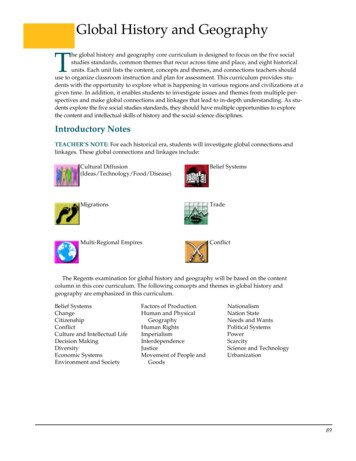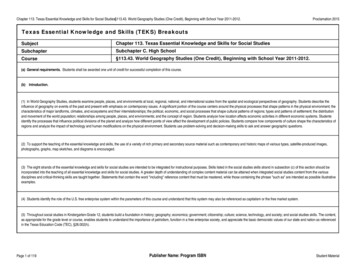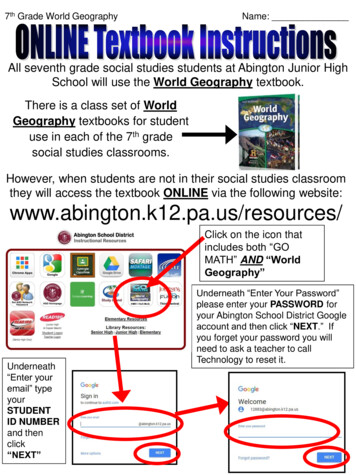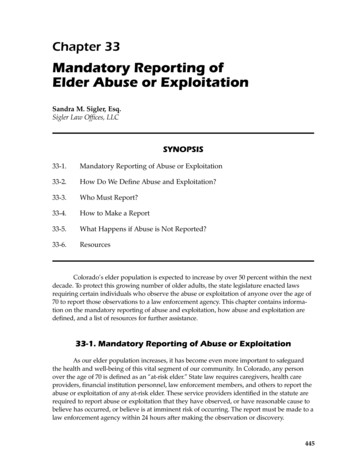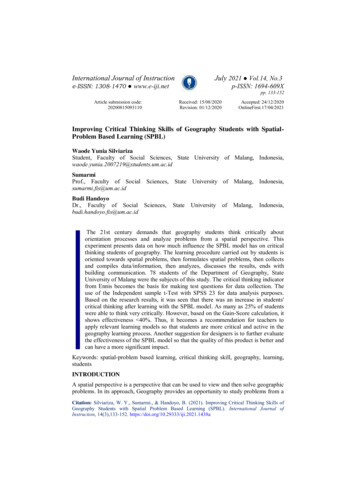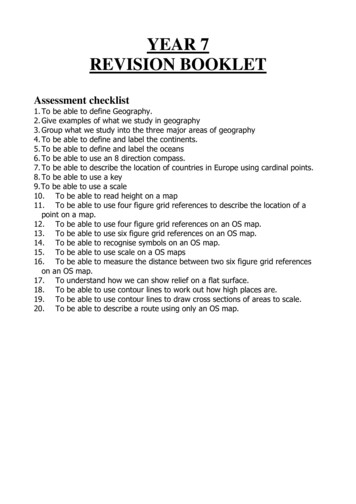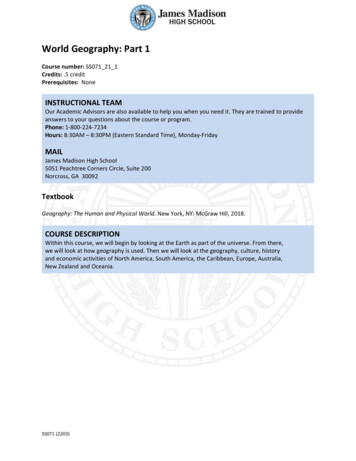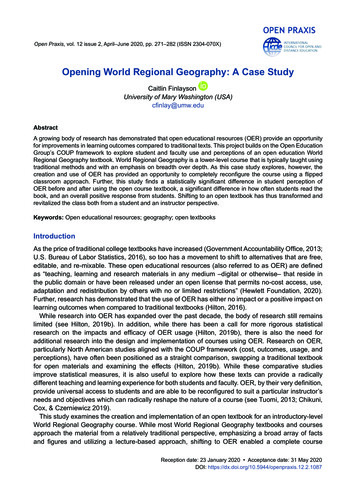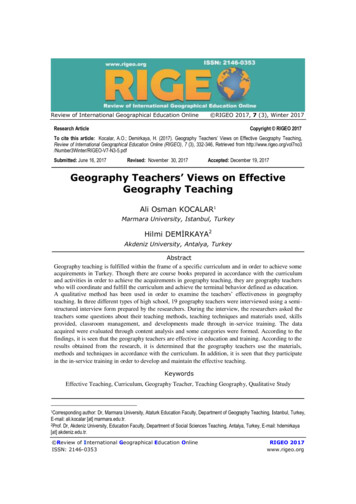
Transcription
Review of International Geographical Education Online RIGEO 2017, 7 (3), Winter 2017Research ArticleCopyright RIGEO 2017To cite this article: Kocalar, A.O.; Demirkaya, H. (2017). Geography Teachers’ Views on Effective Geography Teaching,Review of International Geographical Education Online (RIGEO), 7 (3), 332-346, Retrieved from 7-N3-5.pdfSubmitted: June 16, 2017Revised: November 30, 2017Accepted: December 19, 2017Geography Teachers’ Views on EffectiveGeography TeachingAli Osman KOCALAR1Marmara University, Istanbul, TurkeyHilmi DEMİRKAYA2Akdeniz University, Antalya, TurkeyAbstractGeography teaching is fulfilled within the frame of a specific curriculum and in order to achieve someacquirements in Turkey. Though there are course books prepared in accordance with the curriculumand activities in order to achieve the acquirements in geography teaching, they are geography teacherswho will coordinate and fulfill the curriculum and achieve the terminal behavior defined as education.A qualitative method has been used in order to examine the teachers’ effectiveness in geographyteaching. In three different types of high school, 19 geography teachers were interviewed using a semistructured interview form prepared by the researchers. During the interview, the researchers asked theteachers some questions about their teaching methods, teaching techniques and materials used, skillsprovided, classroom management, and developments made through in-service training. The dataacquired were evaluated through content analysis and some categories were formed. According to thefindings, it is seen that the geography teachers are effective in education and training. According to theresults obtained from the research, it is determined that the geography teachers use the materials,methods and techniques in accordance with the curriculum. In addition, it is seen that they participatein the in-service training in order to develop and maintain the effective teaching.KeywordsEffective Teaching, Curriculum, Geography Teacher, Teaching Geography, Qualitative Study1Correspondingauthor: Dr, Marmara University, Ataturk Education Faculty, Department of Geography Teaching, Istanbul, Turkey,E-mail: ali.kocalar [at] marmara.edu.tr.2Prof. Dr, Akdeniz University, Education Faculty, Department of Social Sciences Teaching, Antalya, Turkey, E-mail: hdemirkaya[at] akdeniz.edu.tr. Review of International Geographical Education OnlineISSN: 2146-0353RIGEO 2017www.rigeo.org
Review of International Geographical Education Online RIGEO Vol. 7, No. 3, Winter 2017, 332-346There are some similar characteristics to define what effective teacher does and isand these characteristics can be summarized as the following; Contrasts the implications of various theories Gives the student a sense of the field, its past, present, and future directions, theorigins of ideas and concepts Presents facts and concepts from related fields Discusses viewpoints other than his/her own (teachingcommons, retrieved in2017).We can clearly see the function and differentiation of the teachers and schools indaily life. For instance; what is the underlying reason that we insistently prefer one ofthe two primary schools at a distance of two hundred meters or some of the classteachers who work at the same school, and that we make every endeavour in order tofulfill such demands? However, the teachers who work at these schools have receivedthe same education, and the schools have similar physical equipment, have registered inthe same central organization and applied the same curriculum. This example showsthat it can be possible to make the schools and classrooms more effective environmentsthanks to the teachers and school principals who care about the effectiveness and lovetheir profession despite many negative conditions. The success of the teachers will leadthe schools to success; the success of the schools will lead the educational institutions tosuccess, and the success of the educational institutions will lead the system of educationto success (Can, 1998).Through the ‘’Directive on Teachers’ Competencies’’ in 2000, the Ministry ofNational Education has stated the model of teacher expected from the universitieswithin the context of education-training competencies, as follows: a- Studentrecognition, b- Instructional planning, c- Material development, d- Teaching, eTeaching management, f- Assessment and evaluation of the plan, g- Guidance, hDevelopment of basic skills, ı- Providing service for the students who need specialeducation, i- Teaching adults, j- Organizing extra-curricular activities, k- Selfimprovement, l- Development of the school, m- Development of relations between theschool and the environment (Tezbaşaran, 2001:37-51).All studies and researches on the characteristics of effective teachers have shown thateffectiveness of the teachers is closely related to student success and satisfaction, andthat they are highly effective on the quality of education-training services (Şen andErişen, 2002:100). Being trained in accordance with the needs of the profession, havingthe desire for self-improvement, loving the teaching profession, putting the students inthe center, clearly determining the aims and being in an insistent struggle for achievingthe related aims can be determined as the qualifications of effective teaching (Can,1998).The American Association of School Administrators, which has examined thecharacteristics of the effective teachers, has achieved two main results: It has beenfocused on the management-education techniques and the personal characteristics(Minor, 2002:117). Willingness, friendliness, humor, trustfulness, high success333
Kocalar, A. O.;Demirkaya, H. (2017). Geography Teachers’ Views on Effective Geography Teaching.expectancy, encouragement, supportiveness, systemness, compatibleness andknowledgeableness can be regarded as personal characteristics of the effective teachers(Cruickshank et al., 1995:315-328).On the other hand; the effective teachers’ professional skills are diversity, to attractthe student’s attention, use the time of teaching effectively, ask questions, perform anopen education, observe the student’s development, provide feedback and exhibitincentive behaviors (Cruickshank et al., 1999:329-351).According to Jensen and Kıley (2000:84–85), the effective teachers have threecharacteristics: 1- Effective teachers are good at making a decision concerning what andhow to teach. 2- Effective teachers have a wide range of teaching skills and the abilityto use them at the right time. 3- Effective teachers have an attitude which facilitateslearning. A warm and positive environment immediately attracts the attention in theclassrooms of these teachers.As is seen, the effective teachers have many characteristics. It may not be possible tohave all of these characteristics. However, it is certain that the more characteristics theyhave the more they can be effective. Though it is difficult to teach some personalitycharacteristics such as being patient and friendly to a teacher candidate of a certain agewhose personality has highly formed but who does not have these characteristics; it ispossible to teach in-class behaviors such as using appropriate teaching methods,communicating through a clear and understandable language, providing feedback andfocusing on the system of reward rather than punishment and to provide them with thenecessary skills and knowledge (Tatar, 2004).Purpose of the StudyThe purpose of the study is to examine the effect of the geography teachers, whowork in secondary education institutions, on education. In accordance with this primaryaim, answers have been searched for the following questions:1. What are the teaching principles used by them in geography teaching?2. What are the teaching approaches used by them in geography teaching?3. What are the teaching methods and techniques used by them in geographyteaching?4. What are the skills they have provided in implementing them in geographyteaching?5. What are the teaching materials used by them in geography teaching?6. How do they provide the classroom management?7. Are education and training performed in accordance with the curriculum?8. Do they provide their self-improvement through in-service education?MethodologyResearch DesignQualitative research approach has been used in the study, and the interview methodin that approach has been applied. The interview is a mutual and interactivecommunication process made for a predetermined aim and based on the question334
Review of International Geographical Education Online RIGEO Vol. 7, No. 3, Winter 2017, 332-346answer method. In this study, the interview has been made through the interview form(Genç, Demirkaya & Karasakal, 2010). In the study interview method used due to thenature of study and the phenomena treated. There are some characteristics of interviewmethod. For instance, you can see the Graphic 1 detailing the features of them explainedby Karasar (2004).By aimsBy number ofBy strictness ofBy people dualUnstructuredLeadersSolving eResearchGraphic 1. Interview Characteristics (Source: Karasar, 2004)Study GroupThe study group of the research has consisted of the geography teachers who work inIstanbul. 19 teachers, who work in Science High Schools, High Schools of SocialSciences and Anatolian High Schools, were determined on a volunteer basis through thecriterion sampling method. Ten of these teachers are female, and nine of them are male.Acceptability and Reliability of Data Collection and Implementation ProcessA semi-structured interview form was applied for the participants in the study. Afterthe pilot scheme of the interview form, expert opinions were received from theinstructors who work in the field of geography teaching, and compatibility of thequestions with the interview was discussed. After the interview form was finalized, anappointment was made for the interview. The interviews lasted about 15-20 minutes.Attention has also been paid for consistency and meaningfulness of the data acquiredin order that the procedures of data collection and analysis can be acceptable. Inaddition, the purpose of the study has been considered from the beginning to the end ofthe study for consistency in the data collection tool and data analysis.Analysis of DataAnalysis of the data acquired was made through the method of content analysis. Themain purpose of content analysis is to reach concepts and relations which can explainthe data collected. Categorization of the data by coding, formation of themes, regulationand definition of the data according to the codes and themes, and interpretation of thefindings are included in the scope of the content analysis (Yıldırım & Şimşek, 2011).Firstly, it was initiated by examining the acquired data, in other words, thedocuments received from the participants. In this examination, two researchers had anexchanged of ideas. Remarkable and important points of the data acquired through theinterviews were determined. After this determination, codes and then categories wereobtained (Demirkaya, 2009). The categories were divided into 8 groups as teaching335
Kocalar, A. O.;Demirkaya, H. (2017). Geography Teachers’ Views on Effective Geography Teaching.principles, teaching approaches, teaching methods and techniques, skills, teachingmaterials, classroom management, and curriculum follow up, and development.Process of the study has been described in detail for its external validity. Answersreceived from the teachers within the scope of this study were given through directquotations in necessary sections without any change. The findings obtained at the end ofthe study were described systematically and clearly, and the descriptions were regulatedand interpreted.Validity and ReliabilityIn qualitative research it is fairly difficult to measure and enhance of validity/credibility and reliability. That stems largely from the nature of qualitative researches.In qualitative practice, validity speaks to the credibility and trustworthiness of theproject and any assertions or conclusions (Leavy, 2017). Transferability is the ability totransfer research findings from one context to another (Lincoln & Guba, 1985).In the present study we tried to enhance these issues by using triangulation. Thismeans that in any study data from several sources, having my study reviewed andcorrected by the participants, and employing other researchers to review my procedures(Creswell, 2012; Merriam & Tisdell, 2015). Before completing study, we shared theresults of the study with the participant and three academics who are expert on the fieldso as to increase the validity and reliability of the study.FindingsThe First Finding: Teaching PrinciplesTeaching principles used in geography teaching provide comprehension of thepurposes and achievements in the curriculum. It is necessary to take these principlesinto consideration in order to provide a regular and right teaching process and to reachthe aims in a short time. Otherwise, education gets more complicated and cannot reachits goal.According to the data acquired from the study; it is seen that the teachers usually usethe principles of actuality (14), student centered teaching (12), clarity (12), and frominduction to deduction. In addition, it is seen that they use in a certain amount of theprinciples called from known to unknown (9), vitality (8), from concrete to abstract (7),and sociability and entirety (5). However, the principles of activity (1) and saving (2)are rarely preferred (Table 1).Table 1The Teaching Principles UsedF1219514Teaching PrinciplesOpennessActivityFrom the known to unknownIntegrityTopicality336
Review of International Geographical Education Online RIGEO Vol. 7, No. 3, Winter 2017, 332-34681275211VitalityAccording to the learnersFrom concrete to abstractSociabilitySavingSoon-awayThe Second Finding: Teaching Approaches (Strategies)Strategy is the implementation of a plan developed in order to reach a goal or a pathfollowed in order to achieve something. On the other hand; strategy in education is anapproach which directs the determination of teaching models, methods, techniques andtools used in reaching the course achievements (Ünlü, 2014). Success of an educationsystem highly depends on competence of the teacher who operates, manages andrestructures this system (Kavcar, 1987).According to the findings obtained, the most attention grabbing one is that 18teachers have used learning through presentation. Only the 19 th teacher has not specifiedthe method of presentation. Learning through presentation is the transfer of organizedinformation to the students regularly and meaningfully by the teachers. In other words;despite the fact that its focus is teacher, it is a method which requires an intensivestudent-teacher interaction.Moreover; the approaches called constructivist learning (5), discovery learning (4)and complete learning (4) are also used by the teachers. However, the method oflearning through research-examination is used only by the fourth teacher (Table 2).Table 2Teaching Approaches UsedF141845Teaching ApproachesResearch-study-learningLearning through inventionLearning through presentationMastery learningConstructivist learningThe Third Finding: Teaching MethodsApplying to various methods in order to provide an effective teaching has become auniversal rule in our day. The number of teaching method which can be chosen by theteacher for an effective education is unlimited as every teacher can develop newmethods by using her/his own creativity (Küçükahmet, 2000:71). When the teacherforms the process of teaching-learning, s/he should benefit from the methods andtechniques based on the student’s activity such as collaborative teaching, brainstorming,discussion, creating concept map, creative drama, programmed teaching, computedassisted teaching, and microteaching (Kuran, 2009).337
Kocalar, A. O.;Demirkaya, H. (2017). Geography Teachers’ Views on Effective Geography Teaching.When we examine the methods used by the teachers in our study; we see that allteachers, as a matter of course, use the method of narration (19) without exception.Because it will be difficult for the students to understand the course subject if it is notexplained by the teacher with the method of narration. Similarly, all teachers stated thatthey use the method of question-answer (18). Only the third teacher said that s/he doesnot use this method. Though repetition method (9), brainstorming (6), demonstrationmethod (5), problem method (4) and group discussion (3) are used by some teachers,these methods are not as preferred as the method of narration or asking questions. Inaddition, project based method, field survey, problem based method are used only bythe teacher one for each. However; any teacher has not stated that s/he used the methodsof collaborative teaching, drama, six hats, and microteaching (Table 3).Table 3Teaching MethodsTeaching MethodsFSix hatsExpressionField tripBrainstormingDramaDemonstrationGroup discussionCollaborative learningMicro teachingProblem solvingProblem based learningProject basedQuestion-answerIteration191653411189The Fourth Finding: SkillsSkills are the intended abilities which need to be acquired and developed throughoutthe educational period and also put into practice in life. In today’s education andtraining concept, it is important to find, use and structure knowledge rather than to takeit as it is (Ünlü, 2014). For that reason, it is not aimed to give only pure information ingeography lesson. Students should acquire some achievements from the lesson. Forinstance; through geographical inquiry skill, the students should be taught to askquestions such as ‘’what, where, when, why, how, who’’ for comprehension of thestages stated in the curriculum (Artvinli, 2010).While geographical inquiry skill (13), map skill (13) and graph-table and diagramreading skill (14) are the most acquired abilities; the skills of observation (8) andevidence use (7) are the other acquired abilities (Table 4). The skills acquired by thestudents will provide them an opportunity to be interested in geography and to get338
Review of International Geographical Education Online RIGEO Vol. 7, No. 3, Winter 2017, 332-346information which will be used by them throughout their life. In his study (2005),Akınoğlu mentions about this issue as follows: It is also necessary to explain thefunction and effect of geography in our life in order that the education of geography canbe effective. In other words, the education should include not only geographicalinformation but also its contributions to our life. If the information given is not usedoutside the class, then the information has no validity. Thus, it is necessary to learn thecorrespondence of all information given on the world, in our environment and life. Themost important problem in teaching geography is that the students are in a struggle forunderstanding the complicated information due to the students’ and teachers’ differentperspectives on the course and that they cannot associate the information given withpractical life.Table 4Skills AcquiredTeaching ApproachesGeographical InquiryObservation skillGraph-Table And Diagram Reading AbilityMap skillUsing EvidenceTime DetectionF138141373The Fifth Finding: Teaching MaterialsThe teaching materials of geography lesson can be listed from the course book to theblackboard in the classroom, from the computer to the projector, from the maps to thestone and soil samples (Doğanay, 2014). While it is necessary to observe the naturalenvironment in teaching the physical geography subjects, there is need to observehuman activities in teaching the human and economic geography subjects. Therefore,the differences between the events and processes in the natural environment and theevents and processes in the human environment will necessitate the use of differentmaterials in teaching these subjects by bringing into the classroom environment (Üçışık,Ünlü & Özey, 2002). For instance, models or photographs should be preferred asteaching materials in a course that the occurrence processes or appearances ofgeographical formations are discussed. On the other hand, the best materials aregraphics in teaching the events and processes related to the population in a geographycourse that the subject of population is discussed. In this case, it is also important toprefer the right material in teaching the specific subject (İnel & Sezer, 2017).In addition that the interviewed teachers frequently use the smart board as theteaching material during the courses (12), the use of presentations through computerassisted projector (11) and the use of maps (12) are highly preferred as the coursematerials. However, the use of globe model (5), course book (3) and blackboard (2) israrely preferred (Table 5).339
Kocalar, A. O.;Demirkaya, H. (2017). Geography Teachers’ Views on Effective Geography Teaching.Table 5Teaching Materials UsedTeaching MaterialsFSmart boardComputer-ProjectionTextbookMapBlack boardModel Sphere121131225The Sixth Finding: Classroom ManagementClassroom management of the teacher is highly important among the factors whichaffect the success of the student. A teacher who shapes education in accordance with thestudents’ levels can be regarded as successful (Creemers, Kyriakides & Antoniou,2013).According to the results obtained, there are no teachers who have problems inclassroom management and cannot maintain the order in the classroom within the scopeof this study. Each teacher has a different style for classroom management and controlsystem. For instance; the fourth teacher “makes an eye contact before verbal warning”,the eleventh teacher “attracts the student’s attention by asking questions”, and theseventeenth teacher “raises his voice in noisy situations” (Table 6).In the light of the information obtained, it is seen that the teachers who have beeninterviewed in our study are effective because the fact that a teacher who provides theclassroom management well will show his/her efficiency in teaching the course.Table 6How do they provide the classroom management?Classroom Teacher12Teacher13Teacher14FNot paying attention to the rules and not compromisingBy taking a serious stance, asking questionsStudents are taught and managed by question-and-answerOral prompts eye contact firstActive teacher roleIt does not allow unnecessary talkBy providing active participation in the course,Gathering attention by doing question-and-answerGood dialogue and positive communicationIt provides good control, it takes place with jokes wherever necessaryAttention to the student by asking questionsDuring question-and-answerIt provides with effective communicationThe course is drawing attention to the student's questions340
Review of International Geographical Education 9 RIGEO Vol. 7, No. 3, Winter 2017, 332-346He does not give permission to those who speak without permissionStudents are given the right to speakIn noisy situations, the tone is amplified.Eye contactAttracting attentionThe Seventh Finding: Following up the CurriculumCurriculum or training program constitutes the teachers’ roadmap. For that reason,following the curriculum will bring a certain success, that is, the content of thecurriculum. The curriculum will meet the needs of the intended education and trainingfor the students as it has an aim. In the interviews made, the majority (15) of the 19teachers follow the curriculum. However, the first and the second teachers stated thatthey follow the curriculum partially. Though the eighteenth teacher said that s/he doesnot follow the curriculum, s/he teaches the lesson in accordance with a certain order(Table 7).Table 7Are education and training performed in accordance with the curriculum?Curriculum er17Teacher18Teacher19FPartially yesPartially NoYesThe Eighth Finding: Providing Self-Improvement12 teachers stated that they follow the in-service training; seminars and conferencesrelated to their own professional developments and also read the publications at times.While a teacher (the teacher 1) clearly expressed that s/he does not do anything for this341
Kocalar, A. O.;Demirkaya, H. (2017). Geography Teachers’ Views on Effective Geography Teaching.purpose, the six teachers (the teacher 2, teacher 3, teacher 6, teacher 7, teacher 17,teacher 18) expressed that they do not make any effort for self-improvement by stayingquiet on the question. Therefore, it is seen that the seven teachers do not show any effortto increase their qualifications (Table 8).As a matter of fact; Turan, Yıldırım and Aydoğdu (2012) argued that the teachers donot attach importance to their professional developments. Moreover, this qualificationtook place on the last rank in a similar study made with the teacher candidates (Bozkuş& Marulcu, 2016). Therefore, it can be said that the lack of importance in theprofessional development before the service continues during the service.Table 8Do they provide their self-improvement through in-service training, seminars,conferences, publications follow-up?Providing r18Teacher19Conclusion and DiscussionIt is expected that those who prefer the teaching profession will desire it by knowing,comprehending and adopting the characteristics of this profession. Such in everyprofession, the teaching profession has its own cognitive, affective and kinematicalbehavior qualities. In addition to written information and mental skills, the candidatesshould also acquire the affective behaviors such as loving the children, learningteaching, and the feelings and attitudes of self-abnegation and willingness. People, wholove humans especially children, are happy with their learning, development and new342
Review of International Geographical Education Online RIGEO Vol. 7, No. 3, Winter 2017, 332-346behaviors, patient, able to smile, forgive, caress and prefer to reward rather than punishthem, should choose the teaching profession (Can, 1998).According to Doğanay (2002); principles are proven and clear ideas which make theresearcher successful. Individual differences should be taken into consideration inlearning. Uniformity in learning both bores the students and decreases their attention.For that reason, not only geography teachers but also all teachers should take theteaching and communication principles into consideration. According to the resultobtained from the findings of the study, it is seen that the teachers cannot showthemselves through different principles because the teaching principles (clarity,actuality, student-centered teaching, from concrete to abstract) used by the teachers arehighly similar.Akınoğlu (2005) stated that firstly the students’ attention to the course should besufficient in order that the geography education can be effective. As far as possible, theeducation should be practical rather than theoretical, and inclusive land tours should beorganized in order to provide the students with an opportunity to observe the naturalenvironment. Most importantly, it is necessary to know how to teach the students thesubject. The students should be asked to adapt the information given to their immediateenvironment and to think about it. The aim of the teacher should be teach learning.The teachers should focus on the learning-teaching methods related to their fields ofstudy for more effective teaching process (Avolos, 2000). The teacher is the person whoguides the learning. The task of the teacher is to regulate the learning experiences and toevaluate whether the students have acquired the terminal behaviors by benefiting fromvarious teaching methods and techniques (Fidan & Erden, 1999).According to the findings obtained from the study, the method of narration and themethod of question-answer are the most common methods used by the teachers. As amatter of fact, these are the methods which must be used by the teachers in geographyeducation. However, there is not any teacher who prefers to use the methods such as sixhats, drama, microteaching and collaborative teaching. Therefore, it is seen that they donot prefer new and different methods and do not apply different teaching methodaccording to the relevant subject.The teacher’s personal characteristics, proficiency as the manager of learningactivities, ability to follow up the learning process and to give the lesson, background,and relations with the students and other individuals affect her/his success in theclassroom (Güçlü, 2002). Moreover, teaching is a profession in which the teacher is amodel to the students and shows cognitive and affective behaviors and also thereflections of these behaviors through her/his own behaviors, attitudes and relations.Accordingly, these constitute kinematical (psychomotor) behaviors and characteristics.In this sense, effectiveness means the acquisition of these qualities. In today’s worldwhere the effectiveness remains on the agenda in every field of study, it is unthinkablethat educational process and educational organizations, which deal with the subjects ofhuman and human behaviors, are not affected by these developments. Effectiveness343
Kocalar, A. O.;Demirkaya, H. (2017). Geography Teachers’ Views on Effective Geography Tea
Jun 16, 2017 · The study group of the research has consisted of the geography teachers who work in Istanbul. 19 teachers, who work in Science High Schools, High Schools of Social Sciences and Anatolian High Schools, were determined on a volunteer basis through the criterion sampling method. Ten
